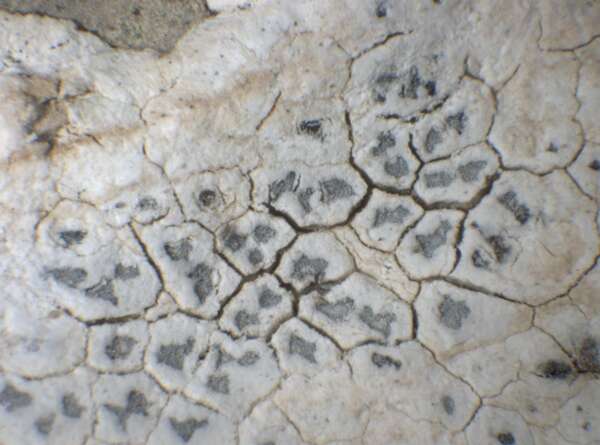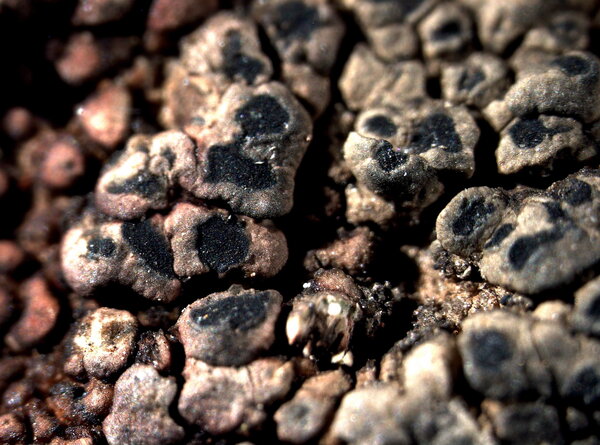Aspicilia polychroma Anzi
Cat. Lich. Sondr.: 59, 1860.
Synonyms: Aspicilia polychroma subsp. hypertrophica Asta & Cl. Roux?; Aspicilia polychroma var. ochracea Anzi?; Lecanora polychroma (Anzi) Nyl.
Distribution: N - Ven, TAA (Nascimbene 2005, Nascimbene & al. 2022), Lomb (Gheza & al. 2023), Piem (Isocrono & al. 2004), VA, Emil (Tretiach & al. 2008, Fariselli & al. 2020), Lig (TSB 33687b). C - Sar.
Description: Thallus crustose, episubstratic, areolate-verrucose, pale greyish white, yellowish white or dark grey, forming > 5 cm wide, more or less orbicular patches, usually thinner in marginal parts, often delimited by a black prothallus. Areoles contiguous, 0.1-1(-2) mm wide, to 0.8 mm thick, the sterile ones flat, the fertile ones convex, the peripheral ones often elongate, giving the thallus an almost placodioid appearance. Apothecia lecanorine-aspicilioid, immersed in the areoles (1-3 per areole), irregular in outline and sometimes confluent, 0.3-0.8 mm across, with a black but more or less densely white-pruinose, concave to flat disc, and a thick, raised thalline margin. Epithecium brownish green to olive, N+ emerald green; hymenium colourless, 85-110 µm high, I+ blue or I-; paraphyses c. 1.5 µm thick at base, the apical cells to 5 µm wide; hypothecium colourless, c. 50 µm high, not underlain by an algal layer. Asci 8-spored, clavate, the thin outer coat K/I+ blue, the wall and apical dome K/I-. Ascospores 1-celled, hyaline ellipsoid, 13-18 x 8-10 µm. Pycnidia immersed, elongated, brown in upper part, with a colourless wall. Conidia thread-like, straight, 20-25 x c. 0.5 µm. Spot tests: cortex and/or medulla K- or K+ yellow, C-, KC-, P- or P+ yellow-orange. Chemistry: with variable amounts of substictic acid (from traces to major).Note: a mainly arctic-alpine, perhaps circumpolar, chemically and morphologically variable species with optimum on more or less calciferous siliceous rocks, most frequent near or above treeline. For further details on the infraspecific taxa see Roux & coll. (2020). The record from Campania by Nimis & Tretiach (2004) was due to a misidentification. See also note on A. verruculosa.
Growth form: Crustose
Substrata: rocks
Photobiont: green algae other than Trentepohlia
Reproductive strategy: mainly sexual
Poorly known taxon in need of further study
Commonnes-rarity: (info)
Alpine belt: rather rare
Subalpine belt: rare
Oromediterranean belt: very rare
Montane belt: extremely rare
Submediterranean belt: absent
Padanian area: absent
Humid submediterranean belt: absent
Humid mediterranean belt: absent
Dry mediterranean belt: absent

Predictive model
Herbarium samples
Growth form: Crustose
Substrata: rocks
Photobiont: green algae other than Trentepohlia
Reproductive strategy: mainly sexual
Poorly known taxon in need of further study
Commonnes-rarity: (info)
Alpine belt: rather rare
Subalpine belt: rare
Oromediterranean belt: very rare
Montane belt: extremely rare
Submediterranean belt: absent
Padanian area: absent
Humid submediterranean belt: absent
Humid mediterranean belt: absent
Dry mediterranean belt: absent

Predictive model
| Herbarium samples |
 Index Fungorum
Index Fungorum
 GBIF
GBIF





